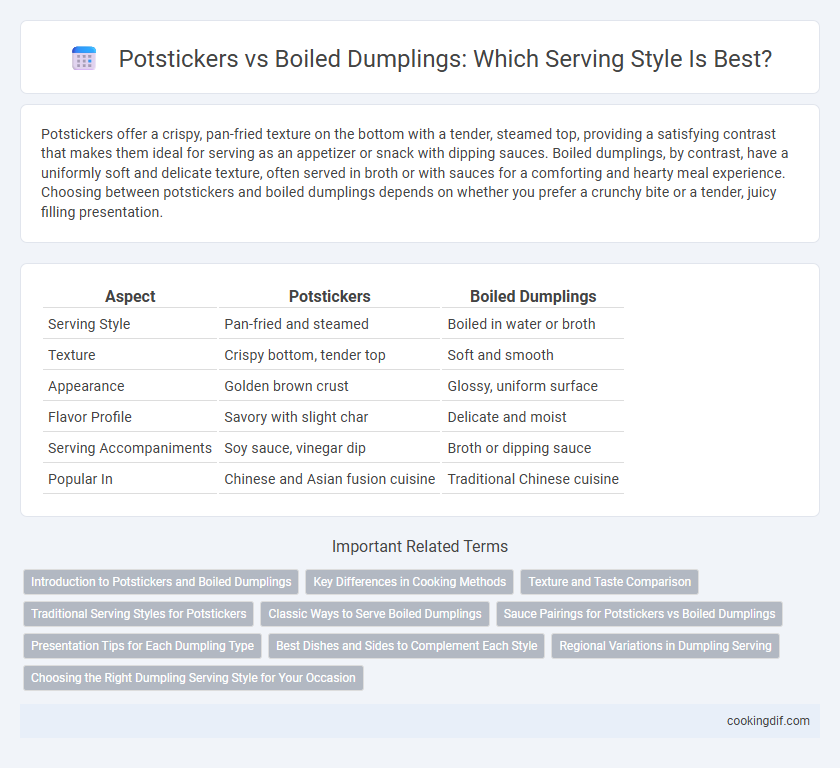Potstickers offer a crispy, pan-fried texture on the bottom with a tender, steamed top, providing a satisfying contrast that makes them ideal for serving as an appetizer or snack with dipping sauces. Boiled dumplings, by contrast, have a uniformly soft and delicate texture, often served in broth or with sauces for a comforting and hearty meal experience. Choosing between potstickers and boiled dumplings depends on whether you prefer a crunchy bite or a tender, juicy filling presentation.
Table of Comparison
| Aspect | Potstickers | Boiled Dumplings |
|---|---|---|
| Serving Style | Pan-fried and steamed | Boiled in water or broth |
| Texture | Crispy bottom, tender top | Soft and smooth |
| Appearance | Golden brown crust | Glossy, uniform surface |
| Flavor Profile | Savory with slight char | Delicate and moist |
| Serving Accompaniments | Soy sauce, vinegar dip | Broth or dipping sauce |
| Popular In | Chinese and Asian fusion cuisine | Traditional Chinese cuisine |
Introduction to Potstickers and Boiled Dumplings
Potstickers, known as guotie in Chinese cuisine, are pan-fried dumplings with a crispy bottom and tender top, offering a satisfying contrast in texture. Boiled dumplings, or jiaozi, are cooked in boiling water, resulting in a soft, delicate exterior that highlights the savory filling inside. Each serving style complements different meal experiences, with potstickers often served as a snack or appetizer and boiled dumplings commonly featured in soups or main dishes.
Key Differences in Cooking Methods
Potstickers are pan-fried dumplings with a crispy, golden bottom and tender steamed top, offering a combination of textures. Boiled dumplings, on the other hand, are fully submerged in boiling water, resulting in a uniformly soft and tender exterior. The key difference lies in potstickers' dual cooking method, combining frying and steaming, while boiled dumplings rely solely on water boiling for cooking.
Texture and Taste Comparison
Potstickers feature a crispy, golden-brown bottom with a tender steamed top, offering a satisfying contrast between crunchy and soft textures, while boiled dumplings have a uniformly soft and chewy outer skin that emphasizes a delicate, juicy filling. The pan-fried preparation of potstickers imparts a rich, savory flavor with slightly caramelized notes, enhancing the overall taste complexity. Boiled dumplings' flavor profile remains lighter and more subtle, highlighting the freshness and natural flavors of the ingredients inside.
Traditional Serving Styles for Potstickers
Potstickers are traditionally served pan-fried to achieve a crispy bottom and tender top, often accompanied by soy sauce or vinegar-based dipping sauces to enhance their flavor. This serving style highlights the contrast in texture that defines potstickers, making them a popular choice for appetizers in Chinese cuisine. In comparison, boiled dumplings are typically served in a broth or with light sauces, emphasizing a softer texture and subtle taste.
Classic Ways to Serve Boiled Dumplings
Boiled dumplings are traditionally served in a clear broth or paired with a soy-vinegar dipping sauce, emphasizing their tender texture and subtle flavors. Unlike potstickers, which are pan-fried for a crispy exterior, boiled dumplings maintain a soft, delicate wrapper that soaks up accompanying sauces beautifully. Classic presentations often include garnishes like chopped scallions or sesame oil to enhance their savory profile.
Sauce Pairings for Potstickers vs Boiled Dumplings
Potstickers are traditionally served with a soy-based dipping sauce combined with rice vinegar and chili oil, enhancing their crispy texture and savory filling. Boiled dumplings pair best with a lighter sauce, often a mixture of soy sauce, sesame oil, and finely chopped garlic or ginger, complementing their soft, delicate dough. The sauce choice accentuates the distinct cooking methods and texture profiles of potstickers and boiled dumplings, creating a balanced flavor experience.
Presentation Tips for Each Dumpling Type
Potstickers offer a crispy, golden-brown exterior that enhances visual appeal, best presented on a warm plate with a garnish of chopped scallions and a side of soy-based dipping sauce for contrast. Boiled dumplings showcase a smooth, delicate skin and are ideally served in a shallow bowl with a drizzle of sesame oil and sprinkled toasted sesame seeds, complemented by a small dish of vinegar or chili oil. Carefully arranging potstickers in a row emphasizes their texture, while clustering boiled dumplings together highlights their tender, plump shape.
Best Dishes and Sides to Complement Each Style
Potstickers, with their crispy bottoms and savory fillings, pair excellently with tangy soy-based dipping sauces and crunchy pickled vegetables to balance textures. Boiled dumplings, typically softer and juicier, are best served in light broths or alongside fresh Asian slaws that enhance their delicate flavors without overpowering. For a complete meal, potstickers work well with fried rice or sauteed greens, while boiled dumplings complement steamed vegetables or ginger-infused dipping sauces.
Regional Variations in Dumpling Serving
Potstickers, commonly pan-fried to achieve a crispy texture, are a staple in Northern Chinese cuisine, especially in regions like Beijing and Shandong. Boiled dumplings, favored in Northern and Northeastern China such as Heilongjiang, emphasize a softer texture and are often served in broth or with dipping sauces. Regional preferences impact the serving style, with southern areas leaning towards steamed or boiled variants while northern regions favor pan-fried methods like potstickers.
Choosing the Right Dumpling Serving Style for Your Occasion
Potstickers offer a crispy, pan-fried texture that works well for appetizers or party platters, providing an appealing contrast between crunchy bottoms and tender tops. Boiled dumplings deliver a soft, juicy bite ideal for soups, family meals, or comfort food settings where warmth and tenderness are desired. Selecting potstickers or boiled dumplings depends on the desired texture and presentation to best complement the occasion's atmosphere and menu.
Potstickers vs boiled dumplings for serving style Infographic

 cookingdif.com
cookingdif.com